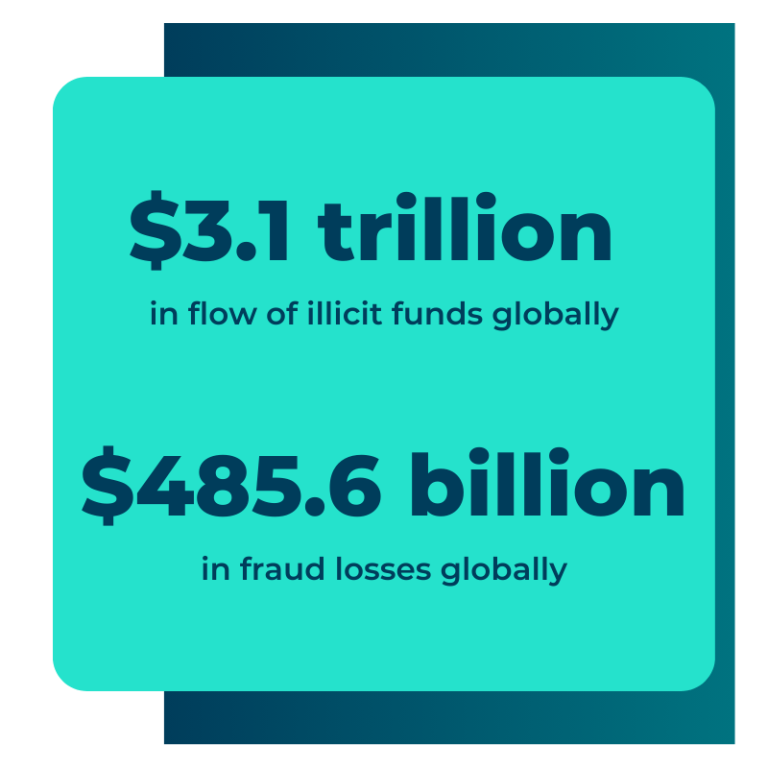
Welcome to a new era in financial crime prevention! As technology advances, so do the tools at our disposal to combat fraud and ensure regulatory compliance. Artificial intelligence (AI) is emerging as a game-changer, offering innovative solutions to the complex challenges faced by financial institutions.
Imagine a world where AI handles repetitive tasks, detects suspicious activities with lightning speed, and frees up valuable resources for more strategic work. This isn’t a distant dream—it’s happening now!
In this article, we’ll explore how AI is transforming the landscape of financial crime compliance. From its incredible potential to the practical ways it can be implemented, we’ll cover everything you need to know. We’ll also look at the challenges and considerations that come with integrating AI into your compliance strategy.
So, let’s dive in and see how AI can help make the fight against financial crime more efficient and effective than ever before.
The financial crime and compliance (FC&C) sector is under more pressure than ever. The complexity and volume of challenges are increasing due to rapidly advancing technology, fluctuating geopolitical climates, and intricate global financial networks. Banks and financial institutions must navigate regulatory hurdles without disrupting the customer experience.
More specifically, the fintech industry is struggling to keep pace with the rapidly evolving regulatory landscape. According to the latest data, 93% of Fintechs find it challenging to meet compliance requirements. Consequently, over 60% of fintech companies paid at least $250k in compliance fines in the past year due to issues such as lack of transaction monitoring, insufficient customer due diligence, and failure to report suspicious activities (Alloy).
One major reason for these difficulties is that most tech companies focus primarily on product development and creating an enjoyable, functional user experience. The pursuit of reducing friction and ensuring seamlessness often takes precedence over compliance matters, as companies wish to avoid disrupting the delicate equilibrium established with their customers.
Furthermore, there is often a lack of internal expertise to manage compliance effectively. Smaller Fintechs typically don’t have a developed compliance team or an in-house compliance officer, leading to misinterpretations of various regulatory directives.
This is where the allure of artificial intelligence (AI) becomes evident. AI can handle repetitive tasks, navigate global regulations, enhance customer interactions, and free up resources for more strategic tasks. AI has the potential to transform the detection and identification of suspicious activities by quickly analyzing vast amounts of data from multiple sources, making it vital for regulatory compliance during customer onboarding and routine operations.
Businesses are eager for AI-driven compliance and productivity improvements. However, they must ensure that the technology is reliable in a highly regulated environment where billions are traded in mere seconds, leaving no room for error.
This article explores how AI is changing financial crime compliance management, the opportunities and challenges it presents, and its practical applications in banking and financial services.
In 2023, global losses from fraud and scams were projected at $485.6 billion, with an estimated $3.1 trillion in illicit funds circulating through the global financial system (Nasdaq Verafin 2024 Global Financial Crime Report). Compliance teams are up against a dynamic criminal ecosystem that constantly evolves to evade detection.
The growth of AI in financial crime compliance is happening as financial crimes become more sophisticated and frequent. The cost of compliance in the U.S. and Canada alone has reached $61 billion (PRWire), a significant operational expense impacting profit margins. The immediacy and volume of transactions add to this complexity.
In 2022, global real-time transactions rose by 63.2%, with 27.8% of all electronic transactions occurring in real time (Euronews).
Identity fraud is also increasing. In the first half of 2023, the U.S. recorded 1,393 data breaches, with financial services being a major target. It’s estimated that one in seven new digital ID accounts opened in 2023 was fraudulent. The incidence of deepfakes in North America more than doubled from 2022 to early 2023 (ITRC).

Fraudsters use various tactics, such as document manipulation, biometric fraud, and deepfakes, to bypass security measures. And, in general detecting fraud in financial institutions is tough. For instance, it oversees so many transactions per day, making it hard to check each one properly. Additionally, fraudsters constantly change their tactics to avoid detection, which implies financial institutions having to adapt their systems constantly.
As regulatory scrutiny intensifies, the finance industry is undergoing significant changes and the number of full-time compliance employees reflects the substantial investment banks are making.
Beyond financial penalties, compliance breaches can damage brand reputation and result in lost revenue. Adopting efficient AI tools can enhance fraud detection, ensure regulatory compliance, and strengthen trust between financial institutions and their customers. Compliance professionals face the dual challenge of applying effective controls and leveraging AI’s potential benefits.
Let’s examine the technology’s challenges and opportunities.
According to a McKinsey study, successfully implementing GenAi in banking can add up to 340 billion annually (McKinsey)
Firms must ensure their AI risk management systems are transparent, interpretable, and justifiable, which is crucial for regulatory compliance and ongoing model evaluation.
Deploying advanced solutions requires significant investment. Partnering with specialists can help manage costs, timelines, and improve risk management.
The quality of system output depends on the input data. For example, verifying the ultimate beneficial owner (UBO) needs an audit trail and expert human input.
The quality of system output depends on the input data. For example, verifying the ultimate beneficial owner (UBO) needs an audit trail and expert human input.
Financial institutions are cautious about opening their systems and data. They aim to gain insights from external data while keeping sensitive information secure.
AI algorithms can identify groups more likely to engage in or be victimized by fraud.
AI can prioritize alerts based on customer risk profiles and historical data, reducing false leads and focusing on critical issues.
AI can detect fraud in media searches and filter relevant negative news, minimizing false alarms.
AI can analyze data across systems to spot anomalies more efficiently.
AI can autonomously verify customers by searching databases and verifying document authenticity.
Advanced algorithms reduce false positives in customer screenings across languages.
AI classifies customer risks and detects hidden transaction patterns.
AI helps ensure compliance with evolving regulations cost-effectively.
AI helps eAI can streamline customer onboarding, improving the customer experience and expediting revenue generation.nsure compliance with evolving regulations cost-effectively.
Generative AI promises to revolutionize risk and compliance management by combining technology with human expertise. These AI tools can analyze large datasets, highlight unnoticed trends, and streamline resource-intensive processes. However, integrating generative AI into financial crime compliance presents challenges, such as:
A balanced approach, leveraging AI’s strengths while retaining human judgment, is essential for navigating these challenges.
In today’s financial landscape, ‘Perpetual Know Your Customer’ (pKYC) is an emerging solution that enables continuous, real-time customer verification, enhancing security and reducing inconvenience.
Traditionally, know your customer (KYC) practices involve verifying customers’ identities when they first engage with a company, usually during the onboarding process, and then at regular intervals, such as every year. After this initial verification, companies evaluate the risk level of each customer, categorizing them as low, medium, or high risk. This classification determines how often their information is reviewed and updated.
However, this method has its drawbacks. Customer information can become outdated, which increases the risk of fraud, harms the company’s reputation, and can lead to substantial regulatory fines. Additionally, the manual checks required can be time-consuming and expensive, involving comprehensive reviews of KYC documents.
Perpetual KYC transforms customer verification by allowing real-time, continuous re-verification. Depending on a business’s requirements, this could involve reassessing the customer’s risk profile with each new interaction or using advanced risk segmentation for every transaction.
This model ensures continuous monitoring and prompt responses to any suspicious activities, utilizing AI to keep customer data updated continuously and avoiding the drawbacks of periodic reviews.

By integrating AI and machine learning (ML), the pKYC system can effectively monitor customer data in real-time. Automated alerts prompt the system to initiate reviews when suspicious behavior or changes in customer information are detected. This approach not only simplifies the review process but also enables companies to tailor their pKYC settings to match their internal policies.
The pKYC method represents a progressive way to meet legal and compliance requirements, detect fraud more quickly, and improve the customer experience by minimizing unnecessary and lengthy document verification processes. It also provides opportunities for better customer insights, potentially leading to cross-selling opportunities.
However, pKYC is still in its early stages, with no standardized models or providers offering all necessary functionalities. Success will depend on effectively leveraging AI to analyze customer data in real-time, suggesting a shift towards specialized KYC service providers to avoid the complexities and costs of overhauling traditional KYC processes.
You might be wondering: “But The Nest, aren’t you an outsourcing partner designed to support startups and scale-ups? What’s your perspective on AI and its effectiveness for these businesses?”
We’ve worked with companies worldwide, tackling a range of compliance challenges. Leveraging our tech capabilities, we’ve successfully addressed these hurdles. The secret to AI’s effectiveness in helping startups navigate regulatory compliance complexities lies in its automation capabilities. AI streamlines compliance by automating data tracking, reporting, and auditing processes, making regulatory adherence simpler. Additionally, AI enhances risk management by predicting and mitigating compliance risks through continuous monitoring and data analysis. This ensures startups stay compliant while minimizing potential issues.

As companies grow, maintaining efficient compliance processes becomes crucial. Startups and scale-ups, especially those operating in the financial or banking environment, face the challenge of managing increasing volumes of data and transactions while ensuring regulatory adherence. Here’s how AI can support (not an exclusive list of course!):
In summary, AI is a powerful tool for startups and scale-ups especially those in the fintech or banking industry, providing efficient, data-driven solutions to complex compliance challenges and supporting sustainable growth.
Integrating AI into financial crimes and compliance systems requires strategic planning. Here are key considerations:
Startups and scale-ups, particularly in the fintech and banking sectors, must navigate a rapidly evolving regulatory landscape while managing increasing volumes of data and transactions. AI offers powerful tools to streamline compliance workflows, provide advanced analytics, and ensure regulatory adherence across multiple jurisdictions. However, the successful implementation of AI requires clear objectives, strategic planning, and trusted partnerships.
By partnering with experts in AI and compliance, startups and scale-ups can effectively leverage AI’s capabilities to automate complex tasks, enhance risk management, and maintain compliance without disrupting customer experience. This balanced approach allows these companies to focus on innovation and growth while confidently meeting regulatory requirements.
And if you didn’t get the hint, we’re here to help you solve those challenges!
Don’t hesitate to reach out, and we’ll assign an AI expert to customize our solution to your needs.
Unlock Tech-Powered Performance with Our End-to-End Capabilities! Harness data, advanced technology, and operational excellence to transform your entire startup or scale-up, from front to back.
